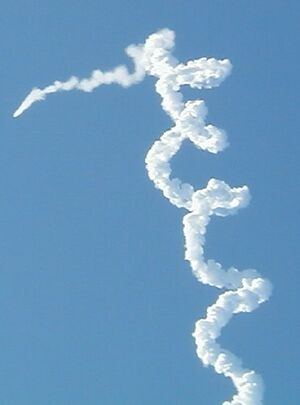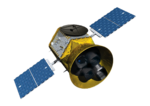Astronomy:Suzaku (satellite)
 A picture of a fully integrated Astro-E2 before vibration tests at ISAS/JAXA. | |
| Names | ASTRO-EII |
|---|---|
| Mission type | Astronomy |
| Operator | JAXA / NASA |
| COSPAR ID | 2005-025A |
| SATCAT no. | 28773 |
| Website | www |
| Mission duration | 2 years (planned) 10 years 1 month 23 days (achieved) |
| Spacecraft properties | |
| Spacecraft type | ASTRO |
| Bus | ASTRO-E |
| Manufacturer | Toshiba[1] |
| Launch mass | 1,706 kg (3,761 lb) [2] |
| Dimensions | 2 metres x 5 metres |
| Power | 500 watts |
| Start of mission | |
| Launch date | 10 July 2005, 03:30:00 UTC |
| Rocket | M-V # 6 |
| Launch site | Uchinoura Space Center, Uchinoura, Kagoshima |
| End of mission | |
| Deactivated | 2 September 2015 |
| Decay date | No earlier than 2020 [3] |
| Orbital parameters | |
| Reference system | Geocentric orbit |
| Regime | Low Earth orbit |
| Perigee altitude | 550 km (340 mi) |
| Apogee altitude | 550 km (340 mi) |
| Inclination | 31° |
| Period | 96 minutes |
| Instruments | |
| X-ray Spectrometer-2 (XRS-2) X-ray Imaging Spectrometer (XIS) Hard X-ray Detector (HXD) | |
 The M-V launch vehicle carrying ASTRO-E veering off course after launch on 10 February 2000. | |
| Mission type | Astronomy |
|---|---|
| Operator | Institute of Space and Astronautical Science (ISAS) / NASA |
| Mission duration | Failed to orbit |
| Spacecraft properties | |
| Spacecraft type | ASTRO |
| Bus | ASTRO-E |
| Manufacturer | Toshiba |
| Launch mass | 1600 kg |
| Dimensions | 2 metres x 5 metres |
| Power | 500 watts |
| Start of mission | |
| Launch date | 10 February 2000, 01:30:00 UTC |
| Rocket | M-V # 4 |
| Launch site | Kagoshima Space Center |
| End of mission | |
| Decay date | Failed to orbit |
| Orbital parameters | |
| Reference system | Geocentric orbit (planned) |
| Regime | Low Earth orbit |
| Perigee altitude | 550 km (340 mi) |
| Apogee altitude | 550 km (340 mi) |
| Inclination | 31.0° |
| Period | 96.0 minutes |
| Instruments | |
| X-ray Spectrometer (XRS) X-ray Imaging Spectrometer (XIS) Hard X-ray Detector (HXD) X-ray Telescope (XRT) | |
Suzaku (formerly ASTRO-EII) was an X-ray astronomy satellite developed jointly by the Institute of Space and Aeronautical Science at JAXA and NASA's Goddard Space Flight Center to probe high energy X-ray sources, such as supernova explosions, black holes and galactic clusters. It was launched on 10 July 2005 aboard the M-V launch vehicle on the M-V-6 mission. After its successful launch, the satellite was renamed Suzaku after the mythical Vermilion bird of the South.[4]
Just weeks after launch, on 29 July 2005, the first of a series of cooling system malfunctions occurred. These ultimately caused the entire reservoir of liquid helium to boil off into space by 8 August 2005. This effectively shut down the X-ray Spectrometer-2 (XRS-2), which was the spacecraft's primary instrument. The two other instruments, the X-ray Imaging Spectrometer (XIS) and the Hard X-ray Detector (HXD), were unaffected by the malfunction. As a result, another XRS was integrated into the Hitomi X-ray satellite, launched in 2016, which also was lost weeks after launch. A Hitomi successor, XRISM, launched on 7 September 2023, with an X-ray Spectrometer (Resolve) onboard as the primary instrument.
On 26 August 2015, JAXA announced that communications with Suzaku had been intermittent since 1 June 2015, and that the resumption of scientific operations would be difficult to accomplish given the spacecraft's condition.[5] Mission operators decided to complete the mission imminently, as Suzaku had exceeded its design lifespan by eight years at this point. The mission came to an end on 2 September 2015, when JAXA commanded the radio transmitters on Suzaku to switch themselves off.[3][6]
Spacecraft instruments
Suzaku carried high spectroscopic resolution, very wide energy band instruments for detecting signals ranging from soft X-rays up to gamma-rays (0.3–600 keV). High resolution spectroscopy and wide-band are essential factors to physically investigate high energy astronomical phenomena, such as black holes and supernova. One such feature, the K-line (x-ray), may be key to more direct imaging of black holes.
- X-ray Telescope (XRT)
- X-ray Spectrometer-2 (XRS-2)
- X-ray Imaging Spectrometer (XIS)
- Hard X-ray Detector (HXD)
- Uses Gadolinium Silicate crystal (GSO), Gd2SiO5(Ce)[7]
- Uses Bismuth Germanate crystal (BGO), Bi4Ge3O12[7]
Results
Suzaku discovered "fossil" light from a supernova remnant.[8]
ASTRO-E
Suzaku was a replacement for ASTRO-E, which was lost in a launch failure. The M-V launch vehicle on the M-V-4 mission launched on 10 February 2000 at 01:30:00 UTC. It experienced a failure of 1st stage engine nozzle 42 seconds into the launch causing control system breakdown and under performance.[9][10] Later stages could not compensate for under performance leaving payload in 250 miles (400 km) x 50 miles (80 km) orbit and subsequent reentry and crashed with its payload into the Indian Ocean.[11][12]
References
- ↑ "Encyclopedia Astronautica – Toshiba". http://www.astronautix.com/mfrs/toshiba.htm.
- ↑ Kazuhisa Mitsuda (25 January 2007). "The X-Ray Observatory Suzaku". Astronomical Society of Japan 59 (SP1): S1–S7. doi:10.1093/pasj/59.1.1. Bibcode: 2007PASJ...59....1T. http://pasj.asj.or.jp/v59/sp1/59s101/59s101-frame.html. Retrieved 4 October 2010.
- ↑ 3.0 3.1 Stephen Clark (4 September 2015). "Japanese X-ray observatory completes decade-long mission". http://spaceflightnow.com/2015/09/04/japanese-x-ray-observatory-completes-decade-long-mission/.
- ↑ すざく(朱雀、Suzaku)命名の理由 2005 JAXA
- ↑ "X-ray Astronomy Satellite "Suzaku" Completes Scientific Mission". National Research and Development Agency (JAXA). 26 August 2015. http://global.jaxa.jp/press/2015/08/20150826_suzaku.html.
- ↑ "Suzaku Mission Declared Complete". Goddard Space Flight Center. NASA. 28 August 2015. http://heasarc.gsfc.nasa.gov/docs/suzaku/news/endofmission.html.
 This article incorporates text from this source, which is in the public domain.
This article incorporates text from this source, which is in the public domain.
- ↑ 7.0 7.1 Tadayuki Takahashi (25 January 2007). "Hard X-ray Detector (HXD) on Board Suzaku". Astronomical Society of Japan 59 (SP1): S23–S33. doi:10.1093/pasj/59.sp1.S23. http://pasj.asj.or.jp/v59/sp1/59s103/59s103-frame.html. Retrieved 4 October 2010.
- ↑ Suzaku Finds "Fossil" Fireballs from Supernovae 12.30.09
 This article incorporates text from this source, which is in the public domain.
This article incorporates text from this source, which is in the public domain.
- ↑ "History | ISAS" (in en). https://www.isas.jaxa.jp/en/about/history/.
- ↑ "1 How did M-V-4 fly?". https://www.isas.jaxa.jp/docs/sat/astro-e/how.html.
- ↑ Ray, Justin (February 10, 2000). "Spaceflight Now | Breaking News | Astro-E believed lost following botched launch". https://spaceflightnow.com/m5/astroe/000210failure.html.
- ↑ Kevin Boyce (2005). "ASTRO-E Launch". NASA Goddard Space Flight Center. http://astrophysics.gsfc.nasa.gov/xrays/programs/astroe/ph/grp-launch.html.
 This article incorporates text from this source, which is in the public domain.
This article incorporates text from this source, which is in the public domain.
Further reading
- Special Issue: First Results from Suzaku Publications of the Astronomical Society of Japan. Vol. 59, No. SP1 30 January 2007. Retrieved 4 October 2010.
External links
- X-ray Astronomy Satellite "Suzaku" (ASTRO-EII) (JAXA)
- JAXA/ISAS Suzaku (ASTRO-EII) mission overview
- JAXA/ISAS Suzaku Information for Researchers
- JAXA report presentation of failure analysis of XRS (in Japanese)
- NASA Astronomy Picture of the Day: Launch of the Red Bird (12 July 2005)
- NASA ASTRO-EII mission description
- NASA/GSFC Suzaku Learning Center
- NASA/GSFC XRS-2 project page
 |






